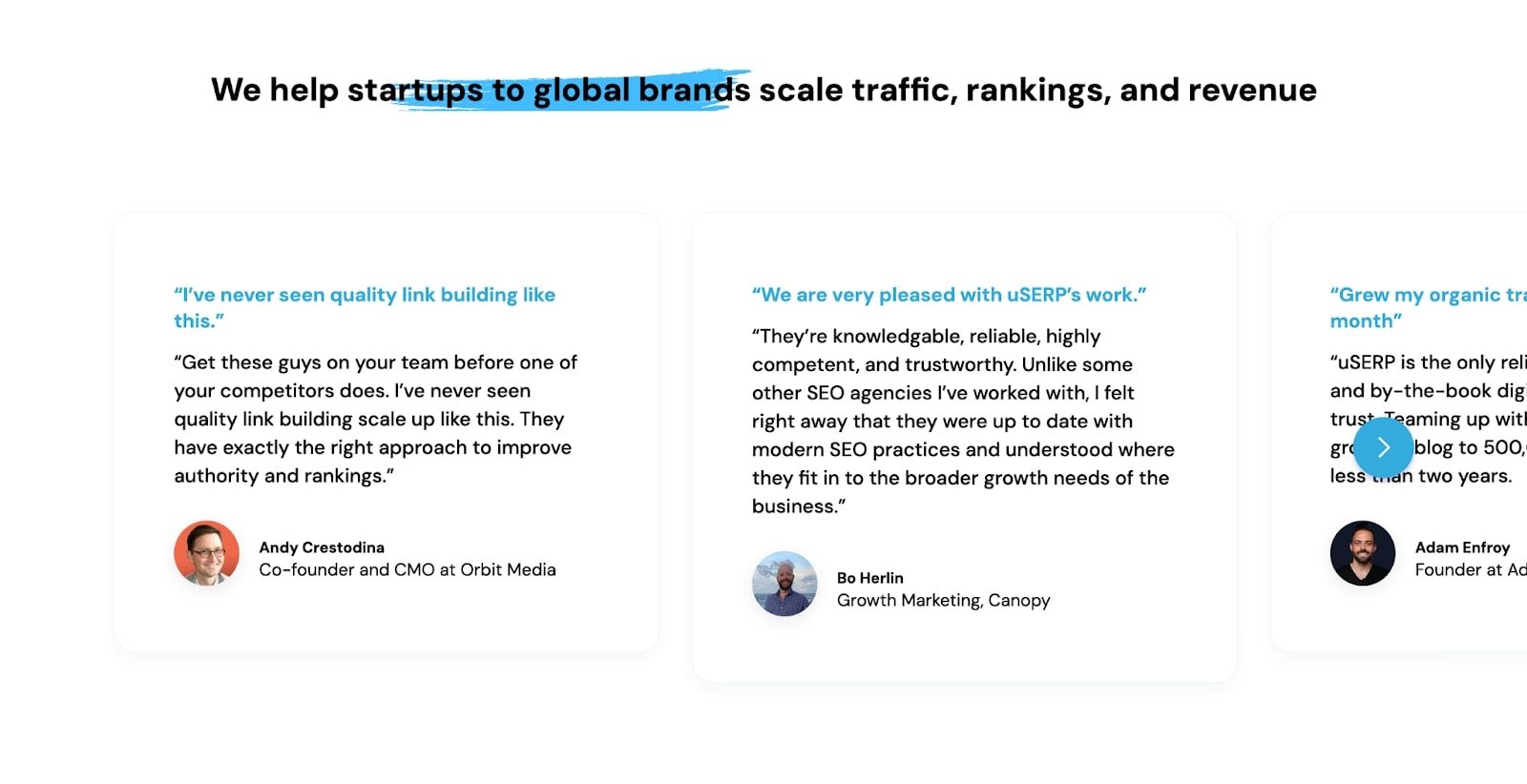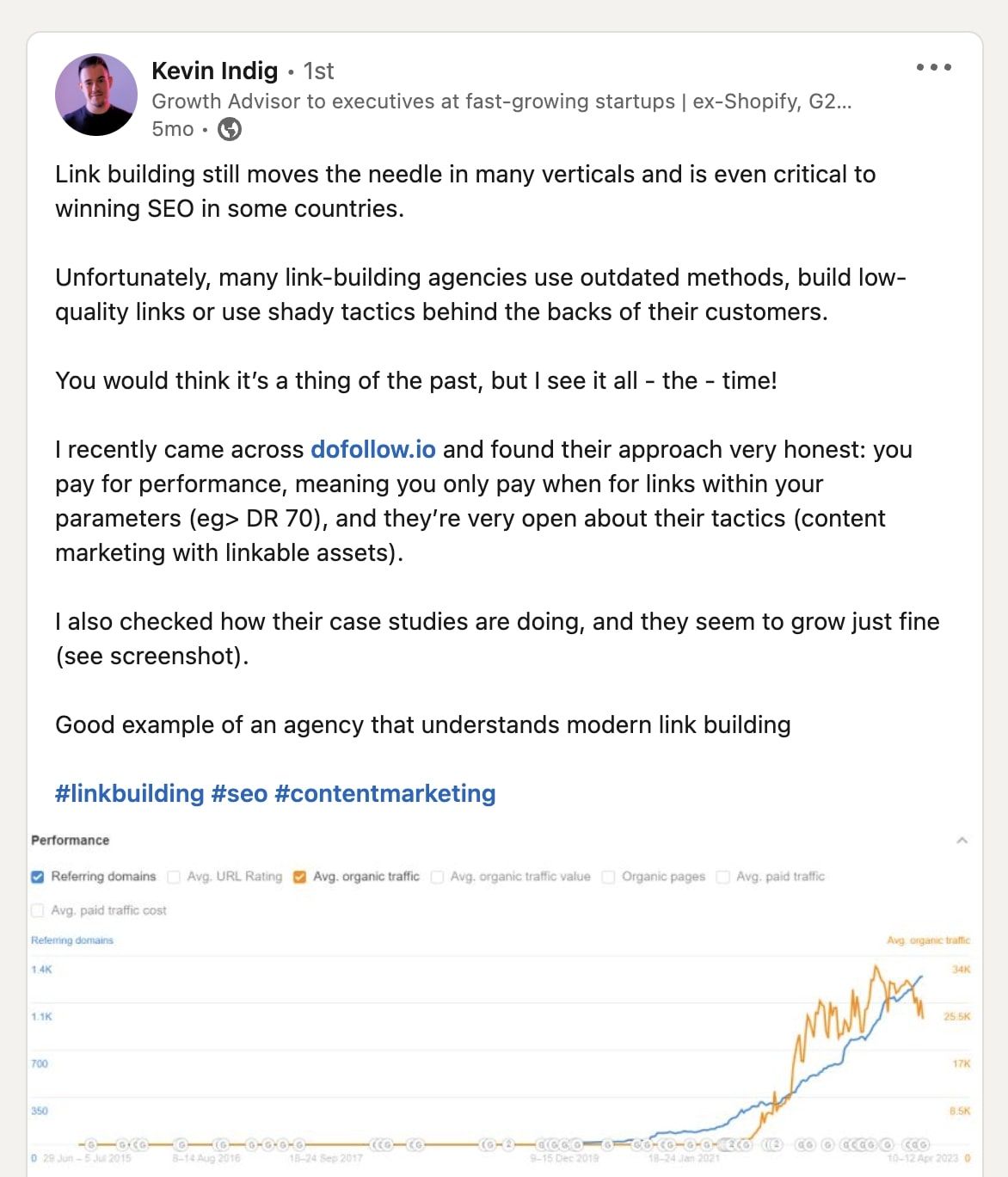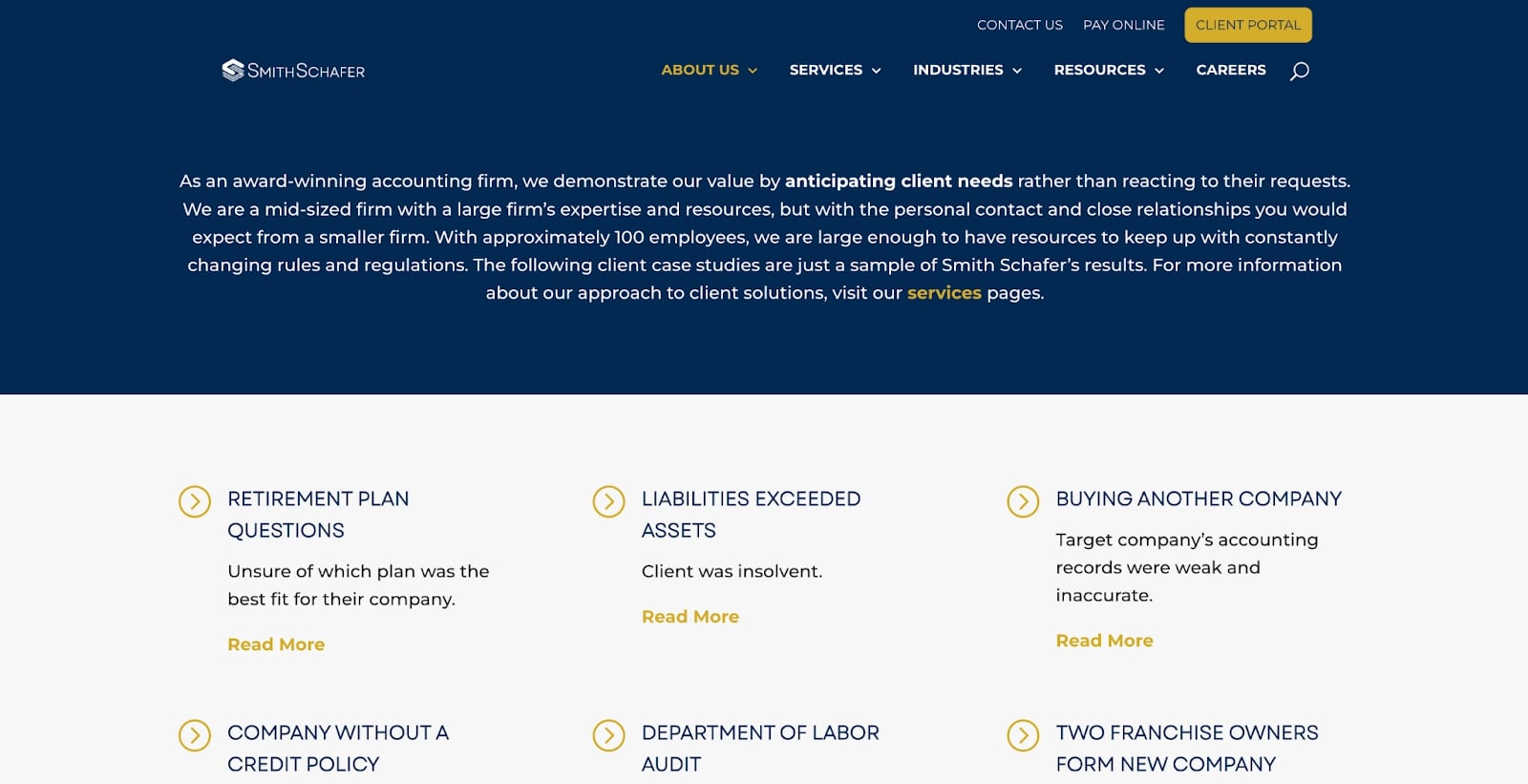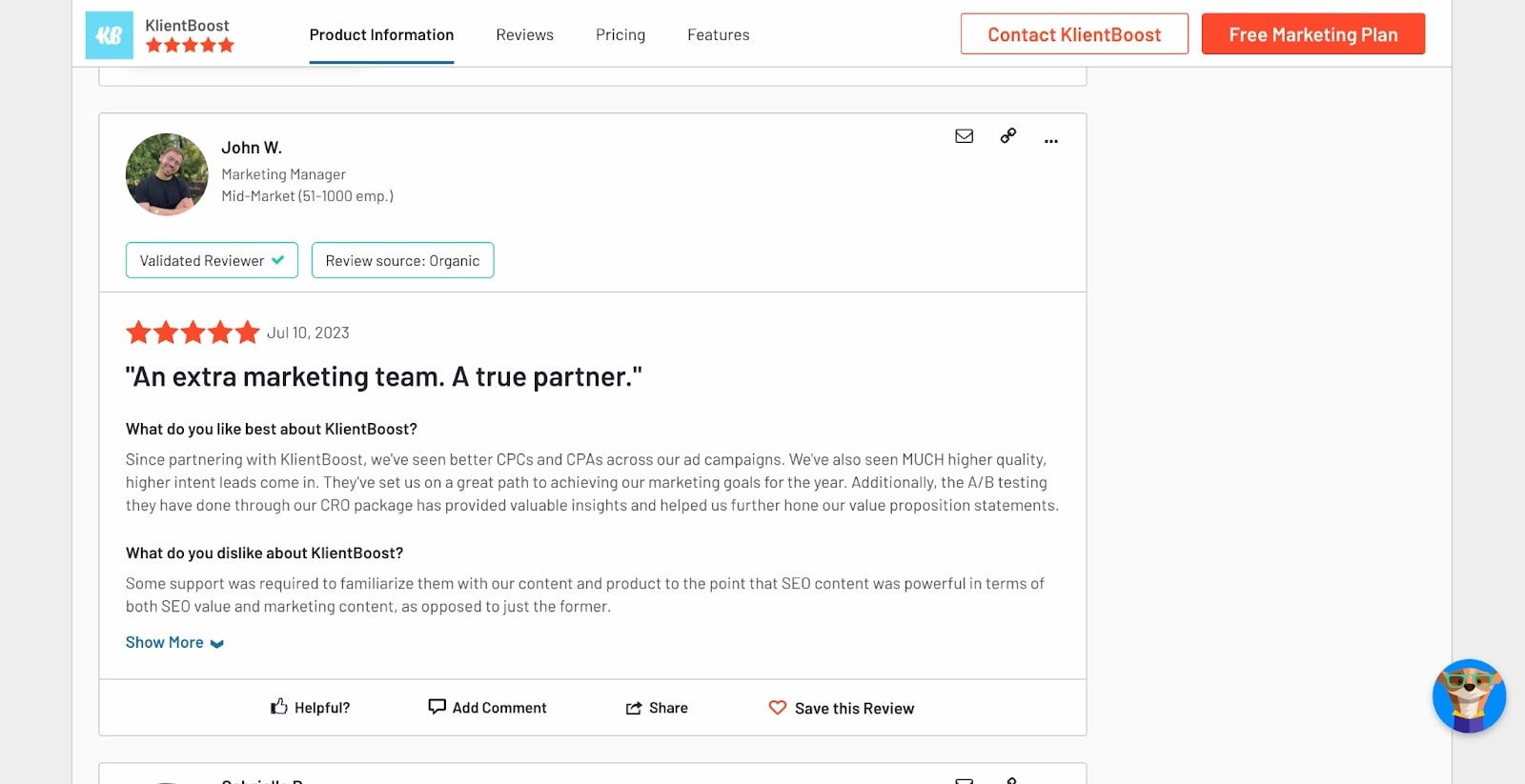Back to Blog
6 client testimonial examples to add to your website
[Hide]
If your friend jumps off a bridge, do you jump off with them?
It might sound like a dramatic question, but it underscores a fundamental truth about human behavior: we are deeply influenced by the actions and opinions of those around us.
This isn't just about peer pressure in our personal lives. In the world of business, this phenomenon is known as 'social proof.' Social proof fuels business growth. And studies show that over 97% of customers read reviews before making a purchase decision — highlighting the power of collective opinion in shaping consumer choices.
Just as we might second-guess a leap off a bridge, many of us look to the experiences of others to guide our buying decisions.
This is why having reviews and client testimonials is so important for your business. So, in this article, we’ll go over some client testimonial examples you should be aware of and how you can go about gathering those testimonials for yourself.
How do you write a good client testimonial?
Creating an effective client testimonial requires more than just asking your clients for feedback. You need to give them the right guidance and questions, make sure their responses highlight your product or service's benefits, and format these testimonials properly.
Framing the right questions
To start with, don't just ask "Can you give us a testimonial?"
Instead, guide your clients towards providing specific details that will benefit potential customers. Ask questions like "What was it about our product/service that solved your problem?", or "Could you share how our service has impacted your daily operations?".
These prompts let clients reflect on concrete experiences which can lead to powerful testimonials.
Showcasing benefits, not features
A good customer testimonial doesn't just talk about what you offer, but rather emphasizes how those offerings have improved a situation or resolved an issue. It helps readers envision themselves benefiting in similar ways from using your products/services.
An example might be: “Before using Copilot’s portal system we struggled with scattered communications and delayed payments. Now everything is centralized making life much easier.” This highlights not only what Copilot does (centralize communications), but also why it matters (it makes things easier).
Be specific and authentic
The best testimonials are specific and authentic because they connect better with prospective customers by giving real-life examples of success stories rather than vague praise. An effective testimony includes specifics such as time saved, percentage increase in productivity or revenue etc., along with personal feelings experienced due to this change.
A great example would be something like: “With Copilot’s file-sharing feature I’ve been able to save 10 hours each week — it feels amazing being able to leave work early without worrying about pending tasks.”
Format matters
The format of a testimonial can greatly impact its effectiveness. A well-structured, easily digestible testimony can grab attention and communicate the value quickly. So how do you structure it?
Here's a straightforward but powerful strategy — the STAR method. It breaks down into Situation, Task, Action, and Result:
- Situation: Begin by setting the scene. Describe the specific situation or challenge that the client was facing prior to using your product or service.
- Task: Highlight the specific task or objective that needs to be accomplished. This could be a particular goal the client aimed to achieve or a problem they wanted to solve with your help.
- Action: Detail the actions taken to address the situation or task. This is where the client explains how they used your product or service and what steps were taken to achieve their goal or resolve their problem.
- Result: Conclude with the outcome of those actions. This could include tangible results such as increased sales, improved efficiency, cost savings, or any other metric that signifies success. Ideally, it should be something measurable, but it can also be a qualitative result, like improved team morale or customer satisfaction.
This kind of structured testimonial can be more persuasive than generic praise because it offers a tangible story of success that potential customers can relate to.
6 client testimonial examples that win new clients
Client testimonials come in various forms, each with its unique benefits. Here are seven different formats to consider:
- Written reviews
- Video testimonials
- Social media shoutouts
- Case study testimonials
- Interview-style testimonials
- Online peer reviews
Okay, let’s dive deeper into each example.
1. Written reviews
The most common type is written reviews, often found on websites or social media platforms. They're easy for clients to provide and straightforward for potential customers to digest. A well-crafted written review, highlighting the strengths of your service, can work wonders.

uSERP, a digital PR agency uses written reviews on their marketing agency website. They clearly show the name of the person giving the testimonial, along with their role in enhancing social proof.
2. Video testimonials
A video testimonial gives a face and voice to the experience — making it more relatable and authentic. It's a potent format but needs good production quality to be effective.

Memorisely, a popular UX bootcamp, uses video testimonials from their clients to showcase the success they’ve been able to provide for their students. Oftentimes, video testimonials can be more effective than written reviews as they are harder to fake.
However, it is important to note that potential clients can see right through fake video testimonials. So to do this part right, and have it be more effective than written testimonials, you need authentic testimonials. Check out Memorisely’s video testimonials on their homepage for some great examples. They also have a dedicated testimonials page for their student alumni.
3. Social media shoutouts
Social media testimonials make use of existing platforms where your clients already hang out — Twitter, Instagram, or LinkedIn, among others. The casual tone and public nature add an element of trustworthiness because they feel less 'manufactured' than other testimonial types.

For example, if you’re a B2B agency, you can gain a lot of referrals and new clients by having popular clients give you a shoutout on LinkedIn. And the larger the reach of your client on social media, the more eyeballs you’re service business will get.
4. Case study testimonials
When you initially think of case studies, you may not think of them as “testimonials.” However, case studies can be an extremely useful tool when trying to close a deal with a potential client. Instead of a simple written review or video claiming that someone had a good experience working with you, a case study allows you to go a level deeper and show customer endorsements.
With case studies, you can walk potential visitors on your website through the entire STAR (solution, task, action, results) process in detail.

For example. SmithSchafer, an accounting firm, uses case studies on their website to showcase their client success stories. This allows them to help reassure potential clients of their quality of work before they decide to do business them.
5. Interview-style testimonials
Interview-style testimonials provide an authentic and detailed glimpse into a client’s experiences and the benefits they’ve gained from working with you. This format is a bit more dynamic compared to the rest because it allows potential clients to dive deeper into a previous client’s journey, challenges, and ultimate resolutions.
Here are some questions you can ask a client you’re currently working with or have worked with in the past:
- Background information: Can you tell us a little bit about yourself and your role/company? How did you first hear about our product/service?
- Identifying the problem: What challenges were you facing before you decided to use our product/service? How were these challenges affecting your day-to-day operations or personal life?
- Decision-making process: Why did you choose our product/service over others in the market? Were there any specific features or aspects of our offering that stood out?
- Actual experience: How has your experience been with our product/service so far? Can you share a specific example where our product/service made a significant difference?
- Benefits and outcomes: What tangible results or benefits have you seen since using our product/service? How have these results impacted your business or personal goals?
- Feedback and improvements: Is there anything you wish our product/service did differently? What additional features or changes would make your experience even better?
- Recommendation: How likely are you to recommend our product/service to others, and why? If you were speaking to someone considering our product/service, what would you say to them?
- Future outlook: How do you see our product/service fitting into your future plans or projects? Are there any other ways we can support or enhance your experience in the future?
By structuring the dialogue with pointed questions, businesses can highlight specific aspects of their offerings and elucidate the tangible impacts made, fostering a more relatable and convincing narrative for potential customers.
6. Online peer reviews
Last but not least, peer reviews on platforms like G2, Capterra, Yelp, or Google My Business offer an unbiased view from customers who've been there, done that. The influence of peer reviews on these online platforms in the decision-making process for potential new clients is undeniable.
Remember that statistic we talked about at the beginning of this article? There’s a 97% chance a potential client will look around online for these types of reviews from your business.

For example, KlientBoost, a marketing agency, as a G2 profile where their clients can go on and leave reviews. If a potential client of theirs goes to Google and searches for “KlientBoost reviews” they will land on their G2 profile.
So now you have it: six different formats of client testimonials. Each one has its unique strengths and contexts where they shine the most. The trick is to use them strategically according to what suits your business best.
How to ask for client testimonials
Asking clients for testimonials might feel like a daunting task. But with the right approach, you can gather compelling stories that show prospective customers how your product or service delivers value. Here are some tactics to kick off your collection of testimonials.
Pick the right time to ask
The best time to ask for a testimonial is when the client's satisfaction is at its peak. This could be after successfully completing a project, solving an issue they had, or delivering exceptional customer service.
Many service businesses that run on Copilot’s client portal find it easier than ever before to gauge when this moment has arrived. By streamlining communication and keeping tabs on every interaction, you'll know exactly when your clients are most likely satisfied and ready to share their experiences.
Make it easy for them to respond
A common mistake businesses make is assuming their happy clients will take out time from their busy schedules just because they were asked nicely. That's why it's essential not only that we ask but also make sure it doesn't turn into another item on their already long list of things-to-do.
You need not request lengthy essays; instead ask them specific questions about what made working with your team enjoyable?
Show gratitude: Make sure they know their input matters
Clients want assurance that their input matters. So make sure there's something in it for them as well — this could range from simple recognition by featuring them prominently on social media platforms or offering discounts towards future services/products as tokens of appreciation.
But remember, their decision should never seem transactional so avoid promising incentives before they agree to provide a testimonial.
Ask open-ended questions
To get detailed and meaningful testimonials, ask open-ended questions. Rather than inquiring if they were pleased with your service, urge them to depict their experience in their own words. Here are some example questions:
- What was the biggest challenge you faced before using our services?
- How did our product/service solve that problem for you?
With these approaches, you’ll have a more efficient time when asking for client testimonials as your success rate may be higher.
Legal considerations for using client testimonials
The world of client testimonials is not just about collecting praise; it also involves some legal aspects that need to be addressed. As you start gathering and using testimonials, there are several key areas you should focus on: privacy concerns, permissions needed, and the accuracy of statements.
Respecting privacy
Clients' confidentiality should always be of the utmost importance when handling testimonials. It is essential to prioritize a customer's privacy not only from an ethical perspective, but also legally. Remember that sharing any information given by a client needs their explicit consent first.
If a customer shares positive feedback privately — say via email or in-person — you can't simply use this as public testimonial without asking them first. This includes both verbal praise and written reviews alike.
Necessary permissions
Gaining permission goes beyond just respecting privacy—it's about legally protecting your business too. The Federal Trade Commission (FTC) has clear guidelines around endorsements and testimonials in advertising which every business owner must follow.
To comply with these rules, make sure to get express approval before featuring someone’s face or words in your marketing materials. An email confirmation will usually suffice here, but consider seeking professional advice if you’re unsure about anything.
Maintaining accuracy
Avoid making false promises based on misleading claims. Any exaggerated results claimed in the testimonial could lead to serious repercussions under FTC regulations — if it sounds too good to be true, then it probably isn’t true.
In fact, there’s a section in the FTC Act that prohibits "unfair or deceptive act or practice in or affecting commerce..." So, make sure that all testimonials you use are truthful and can be verified with proof if required.
Conclusion
Client testimonials are your business's blockbuster trailers. They capture attention, spark curiosity, and draw in audiences.
You've learned the art of crafting them. The power they hold to convert potential leads into loyal customers is now clear. The secret? Real stories from real clients praising your products or services. There's nothing quite like a good success story!
Getting client testimonial examples might seem daunting at first, but you've got this! You know when to ask for them and how to do it without sounding pushy. Above all, you understand the legal aspects that come with using these golden nuggets of praise.
Share this post
Sign up for our newsletter
Subscribe to our newsletter to receive emails about important announcements, product updates, and guides relevant to your industry.
